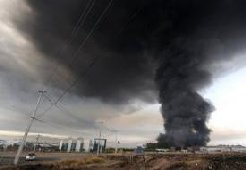"This was a big one. A really big one,'' said Dr. Tim Dixon, geophysics professor at the Rosenstiel School of Marine and Atmospheric Science in Miami, speaking of the magnitude 8.8 earthquake that struck near Chile Saturday morning.
How thunderous is 8.8 quake on the Richter scale? The energy released is between 500 and 900 times that of the magnitude 7.0 quake that hit Haiti on Jan. 12, he said. On the complex scale that measures earthquakes, an 8.0 quake releases 30 times the energy of a 7.0, and a 9.0 would release 30 times that, meaning 900 times more energy. An 8.8 would be somewhat less, Dixon said.
The amount of damage quakes cause depends in large part on the kinds of soils in which they take place, how close they are to populated areas and whether buildings have been put up to withstand earthquakes.
Saturday's earthquake near Chile took place along the ``Peru-Chile Trench'' fault line that runs the length of South America about 80 miles offshore. It runs north past Central America and about halfway up Mexico, Dixon said.
It's part of the boundary between two massive tectonic plates -- the Nazca plate in the Pacific Ocean and the South American plate. The earth is divided into about a dozen big plates that constantly shift against each other, occasionally causing earthquakes.
In Haiti, the earthquake was on the Baranquillo fault line that starts in Jamaica and runs east through Haiti and into the Dominican Republic. It is a lateral fault, with two plates moving past each other side-to-side causing mostly lateral shaking in a quake.
In Chile, the quake was on a ``thrust fault,'' with the Pacific Ocean's Nazca plate diving down under the South American plate over geologic eons. The fault line is at the surface about 80 miles offshore. It then dives down under the continent, and is about 80 miles down by the time it runs underneath the Chilean capital of Santiago.
The farther down an earthquake occurs, the less damage it does on the surface, he said.
The offshore quake has ruptured part but not all of the fault zone, increasing pressure on the rest of the fault line and increasing the chances of another quake under Santiago or elsewhere up and down the Chilean coast.
More than 20 aftershocks have hit near Chile since the big earthquake Saturday morning, one as big as magnitude 6.9, according to the U.S. Geological Survey.
``The next few days will have significant aftershocks,'' Dixon says. ``A 7.0 like the one in Haiti is certainly possible in Chile,'' he said.
More aftershocks also are probable up and down Chile's coast.
Dixon stressed that there is no connection between the Haiti and Chile quakes.
``Somewhere in the world we get a 7.0 quake about once a month. An 8.8 is much rarer. We might get about one a year.''
Since the big Jan. 12 quake, Haiti has experienced more than 60 aftershocks ranging up to magnitude 5.9. The aftershocks have been decreasing in size and frequency. But the fact that the quake near Port-au-Prince ruptured only part of the fault line along which it runs already had increased the risk of another big quake even closer to Port-au-Prince.
PHOTO CAPTION
Smoke from a burning building fills the sky in the outskirts of Santiago.
Source: commondreams.org


 Home
Home Discover Islam
Discover Islam Quran Recitations
Quran Recitations Lectures
Lectures
 Fatwa
Fatwa Articles
Articles Fiqh
Fiqh E-Books
E-Books Boys & Girls
Boys & Girls  Articles
Articles










